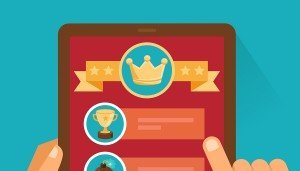Gamification is in Enterprise Mobility’s Future

Over the last few years, “gamification” in enterprise mobility has become an emerging trend.
Gamification is defined as a business strategy that applies game mechanics to a non-game situation to drive or change behavior. How is this relevant to mobility? Gamification is not about turning work into a game, but about offering a new way for employees and customers alike to become more engaged through performance metrics, feedback and progression. Game mechanics are the building blocks that create an optimal gaming experience. These are the fundamentals that create an engaging game.
If gamification is effectively implemented in an organization, it can be a valuable strategy to keep employees motivated and productive. With mobile apps, information-sharing is instantaneous, and tracking successes can be tracked any time.
To understand how gamification can be used in an organization, you must understand game mechanics and how they can be applied to enterprise mobility and mobile apps. Some of the elements of game mechanics include:
Achievement – A physical or virtual representation of accomplishment
Blissful productivity – Playing a game in conjunction with hard work makes you happier than relaxing
Bonuses – rewards for completion of a task
Cascading information theory – The theory that information should be released in smaller increments so users can easily gain understanding.
- Challenges – Obstacles that players must overcome to be successful in a game
2)Collaboration – the viral rallying of a group of players to solve a common problem or obstacle - Countdown – limiting time to accomplish certain tasks and challenges
In4) finite game play – games that don’t have an explicit end defined - Levels – a method to measure progression in a game
- Loss aversion – When players avoid scenarios that create a loss of status
- Lottery dynamic – When the winner of a is determined by a chance-driven method
- Points – A numerical value to measure progress in a game
- Progression – a measurement of progress through a set list of tasks and duties
- Reward schedules – a predetermined delivery process to earn rewards in a game
- Status – The level, rank, and accomplishment of a player
- Urgent optimism – A player’s compelling desire to tackle obstacles quickly with an expectation of success
Virality – a method of spreading engagement and game play among a group
By applying these elements of game mechanics, you can develop an app that is compelling and relevant for your users. For example, if you have a team of sales reps in your organization, gamification can be used to help them track metrics, their sales goals, and how they compare to their on an app. The app can be designed with gamification elements such as scorekeeping and live updates to make it more compelling for the sales team to use.
If you’re working for a financial institution looking to attract new customers and increase brand loyalty, gamification can be implemented in the sector. Using badges, or leaderboards on an app to represent rewards, points, and credits can make the app more appealing to download. With so many millennials who are accustomed to using mobile devices and living in a connected environment becoming a part of the workforce (and opening bank accounts), the financial and banking sectors would be wise to adopt new techniques to target them.
Field workers can use a gamification app to meet the goals of fixing issues the first time they’re dispatched. Metrics that track cases and when they’re resolved, and how many times they may have to go out again to fix issues. Mobile apps with gamification can help them keep track of how many times they have helped a customer or on a site. Leading field service workers can be rewarded with vouchers or points for their contributions to keeping the organization operational and productive. Achieving a good score can become a part of an annual review, part of a company bonus structure, or a trigger for a worker to get additional training, or even something as simple as a voucher to the company cafeteria for a free lunch.
Gamification can be applied to mobile apps to measure metrics such as business goals, Key Performance Indicators (KPI’s), positive and negative activity, use cases, change management, and monitoring success. Whether you’re implementing mobile apps for your employees or customers, an app that has elements of gamification can make them appealing to use and keep your target users engaged.